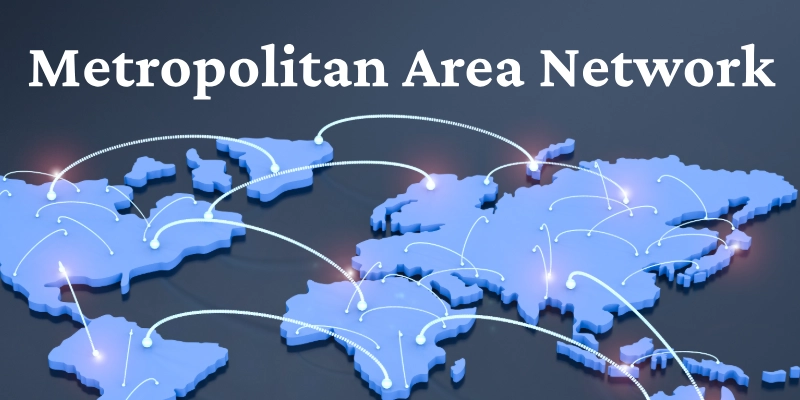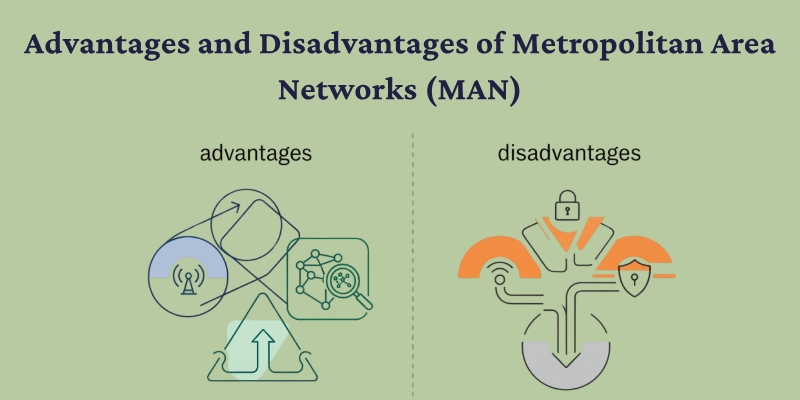What is the Metropolitan Area Network (MAN)? Definition, Features, and Examples
Published: 14 Sep 2025
A Metropolitan Area Network (MAN) connects multiple Local Area Networks (LANs) across a city, typically covering distances of 5 to 50 kilometers. It provides high-speed communication for organizations, universities, and government institutions within urban areas.
By using advanced technologies like fiber optic cables and broadband services, a MAN ensures fast and reliable data transfer. It acts as the perfect middle ground between LAN and WAN, making it a vital part of modern network infrastructure.
In this article, we will explore Metropolitan Area Networks (MANs) in detail, including their features, advantages, challenges, and real-world applications.
What is the Metropolitan Area Network (MAN)?
A Metropolitan Area Network (MAN) is a large-scale network that connects multiple Local Area Networks (LANs) within a city or a large town. It covers a range larger than a LAN but smaller than a WAN, making it ideal for citywide networking. Typically, MANs rely on fiber optic cables and other high-bandwidth technologies to deliver broadband services and support efficient urban area communication.

How Does a MAN Work?
A MAN acts as a network backbone, linking multiple LANs across different locations within a city. For example, several office buildings, universities, and data centers can be connected via fiber optic cables. These connections ensure local connectivity within the city while also serving as a bridge to wider network infrastructure, such as WANs and the internet.
Characteristics of MAN
The following are the key characteristics of a Metropolitan Area Network (MAN) that make it distinct from LAN and WAN.
- Coverage area: Typically spans 5–50 kilometers across a city.
- Uses fiber optic cables and wireless links for high-speed connections.
- Supports public and private networks depending on ownership and usage.
- Provides high-speed data transfer for enterprises, government bodies, and data centers.
Components of MAN
A MAN consists of various elements of network infrastructure such as:
- Routers and switches for directing traffic.
- Fiber optic cables or wireless links for backbone connectivity.
- Service providers offering broadband services.
- Network management systems to ensure security, uptime, and scalability.
Types of Metropolitan Area Networks
The following are the main types of Metropolitan Area Networks (MAN) commonly used in urban communication and connectivity.
- Fiber Distributed Data Interface (FDDI) – Uses optical fiber for fast and secure transmission.
- Distributed Queue Dual Bus (DQDB) – Designed for efficient bandwidth sharing in large networks.
- Asynchronous Transfer Mode (ATM) – Provides low-latency, high-speed packet switching.
- Modern Ethernet-based MANs – Scalable, cost-effective, and widely used today.
Advantages of MAN
The following are the major advantages of a Metropolitan Area Network (MAN). These benefits highlight why MANs are widely adopted in cities and large organizations. By understanding these advantages, you can see how MANs improve communication, speed, and connectivity across urban areas.
- High-speed data transfer across large distances.
- Cost-effective solution for organizations spread across a city.
- Enhanced urban area communication and collaboration.
- Provides strong support for public and private networks.
- Ideal for citywide networking and shared access to data centers.

Disadvantages of MAN
The following are the main disadvantages of a Metropolitan Area Network (MAN). While MANs offer many benefits, they also come with certain challenges. Being aware of these drawbacks helps in making better planning and deployment decisions.
- Higher setup and maintenance costs compared to LAN.
- Security risks in public networks.
- Complex network management and troubleshooting.
- Heavy reliance on service providers for uptime and quality.
Use Cases & Industry Applications
The following are some common use cases and industry applications of Metropolitan Area Networks (MAN) across different sectors.
- Universities and colleges: Connect multiple campuses with high-speed links.
- Government agencies: Enable secure urban area communication for different offices.
- Telecom and ISPs: Deliver broadband services and internet access.
- Enterprises: Link multiple branches or offices across a city.
- Smart cities: Manage IoT devices, surveillance, and infrastructure efficiently.
MAN vs LAN vs WAN (Comparison)
| Feature | LAN (Local) | MAN (Metropolitan) | WAN (Wide) |
| Coverage Area | Building or campus | Citywide networking | Country/global scale |
| Speed | Very high | High (fiber-based) | Varies (medium to high) |
| Ownership | Private | Mix of public and private networks | Mostly public (ISPs) |
| Cost | Low | Medium to high | High |
| Best Use | Homes, offices | Cities, enterprises | Global organizations |
Challenges & Limitations
Below are some key challenges and limitations of Metropolitan Area Networks (MAN) that organizations should consider.
- Cybersecurity risks in public networks.
- Expensive to maintain large network infrastructure.
- Scalability issues with growing city demands.
- Dependence on fiber optic cables and service providers.
Future Trends in MAN Technology
The role of MAN is rapidly evolving with technological advancements:
- Integration with 5G networks for ultra-fast urban area communication.
- Support for cloud services and data centers.
- Expansion of fiber optic cables to cover more areas.
- Increased importance in smart city projects and IoT connectivity.
How to Plan & Deploy a MAN
Below are the essential steps to plan and deploy a Metropolitan Area Network (MAN) effectively.
- Define requirements: coverage area, bandwidth, and security.
- Choose a suitable transmission medium (fiber optics, wireless, or hybrid).
- Implement strong network management practices.
- Ensure scalability for future growth in citywide networking.
Conclusion
In this article, we’ve covered What is the Metropolitan Area Network (MAN) in detail. From its definition to its applications and benefits, it’s clear that MAN plays a crucial role in connecting large networks across cities. Personally, I’d recommend diving deeper into real-world case studies of MANs to truly understand how they can transform connectivity.
If you found this article helpful, don’t forget to share it with others and explore more of our guides to expand your knowledge.
FAQs about Metropolitan Area Network (MAN)
The following are some frequently asked questions about Metropolitan Area Networks (MAN) with clear and simple answers.
The main purpose of a Metropolitan Area Network (MAN) is to connect multiple Local Area Networks (LANs) within a city or metropolitan region. It ensures smooth local connectivity, fast data transfer, and resource sharing between organizations, institutions, and businesses spread across the area.
A MAN typically covers a city or large urban area, while a Wide Area Network (WAN) can span across countries or even continents. Compared to WAN, MAN offers higher speeds and more reliable communication in urban environments, but its reach is limited to a smaller geographical scale.
MANs are widely used by universities, government offices, enterprises, and Internet Service Providers (ISPs). These organizations rely on MANs for citywide communication, efficient resource sharing, and delivering broadband services to end users.
Most MANs are built using fiber optic cables due to their ability to provide high bandwidth, speed, and reliability. In some cases, wireless technologies or leased lines are also used to extend the network.
Examples of Metropolitan Area Networks include municipal networks connecting different government departments, university campus networks, and telecom-based broadband services that operate across cities. These examples show how MANs support both public and private needs.
A MAN offers fast data transfer, improved connectivity, and cost-effective networking across a city. It also supports better communication, centralized management, and access to shared resources for multiple organizations.
Despite its benefits, MANs can be expensive to set up and maintain, especially due to the infrastructure required. They may also face challenges such as security risks, complex management, and potential downtime if not properly monitored.

- Be Respectful
- Stay Relevant
- Stay Positive
- True Feedback
- Encourage Discussion
- Avoid Spamming
- No Fake News
- Don't Copy-Paste
- No Personal Attacks

- Be Respectful
- Stay Relevant
- Stay Positive
- True Feedback
- Encourage Discussion
- Avoid Spamming
- No Fake News
- Don't Copy-Paste
- No Personal Attacks





